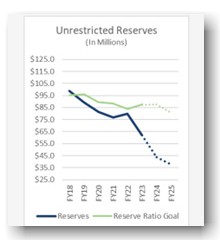By David Loomis
INDIANA – Spring 2024 commencement passed uneventfully at IUP. No student protests disrupted graduation ceremonies, despite the prominence of commencement speaker Pennsylvania Gov. Josh Shapiro. The Democrat, an observant Jew, defender of Israel and critic of pro-Palestinian demonstrators on college campuses, was glowingly profiled in The New York Times on the day of his IUP speech.
The 1,566 graduates in the Class of 2024 sat for oratory free of references to current events that alter and illuminate our times – including events that may alter and darken the future of the new graduates’ alma mater.
Mr. Shapiro, for example, did not sell his sweeping Jan. 29 plan to overhaul higher education in the commonwealth. The plan would slash tuition and fees for low- and middle-income students to $1,000 per semester from the current $7,716 semester average for state-funded PASSHE schools, including IUP. For other students, the state system voted in April to freeze tuition for a seventh consecutive year, an effort to promote the social and economic mobility that regional public universities like IUP offer.
The governor’s budget plan includes ambitious spending hikes for both basic and higher education – overdue in a state that ranks 49th in the nation in public investment. Republicans in the legislature promptly called Mr. Shapiro’s proposal “unicorns and rainbows.” Or, as Senate Majority Leader Joe Pittman, R-Indiana, put it, “absolutely fiscally irresponsible and unsustainable.”
(No mention of lawmakers’ responsibility for last year’s landmark court ruling that the state’s underfunding of public education is unconstitutional under Article III, Section 14. Lawmakers did not appeal the decision.)
Mr. Pittman and other Republicans evidently perceive their parsimony as an opportunity to privatize education on the public’s dime.
BUT BIPARTISAN SUPPORT has greeted IUP’s proposed school of osteopathic medicine, promoted as a boon for public health in rural Pennsylvania and a boost for IUP.
In January, Mr. Pittman announced he found $2 million in the state’s 2023-2024 budget for the med school. U.S. Sen. John Fetterman, D-Pa., is seeking $2 million in federal funds in fiscal year 2024-2025. Ditto U.S. Rep. Guy Reschenthaler, R-14th District, representing Indiana County.
Meanwhile, IUP reported a 6.5 percent boost in spring 2024 enrollment over spring 2023, a hopeful sign after a decade of decline.
Good news. Will it last?
IUP’s osteopathic med school will be competitive as the commonwealth’s first public D.O. school. But it will compete with three other private Pennsylvania institutions, including a brand new program at Duquesne University in Pittsburgh. IUP planners nevertheless are banking on strong demand.
Overall university enrollment, however, presents a challenge. The demographic decline that colleges have foreseen for years – the “enrollment cliff” – is projected to persist, according to Census Bureau forecasts. Enrollment and demographic declines remain embedded in Pennsylvania’s higher ed forecast. Even mighty Penn State is downsizing its workforce by 10 percent.
But what of that 6.5 percent spring 2024 IUP enrollment boost? Campus watchers attribute IUP’s gain to short-term losses suffered at the newly consolidated Penn West University. Long-term demographic trends still are projected to “crater.”
DECLINING DEMOGRAPHICS and low enrollments mean less money, as IUP management noted in recent public and private budget presentations.
“As enrollment declines, revenue declines,” explains a slide shown on the IUP campus by Debra Fitzsimons, vice president for. administration and finance, on Jan. 29, coinciding with Gov. Shapiro’s higher-ed overhaul pitch.
The slide show was provided by an IUP source who attended the campus event. The Jan. 29 showing was private.
“The intent is to have it discussed by our internal community,” wrote Michelle Fryling in a March 10 email.
A SAMPLING of Ms. Fitzsimons’ slides may sound familiar to an already diminished (and partly demolished) university community:
— “We have seen a steady decline in student enrollment. We need to scale our resources to the number of students.”
— More reductions in faculty and non-faculty workforce may be in store through fiscal year 2024-2025, beginning July 1, and institutional aid to students may be reduced.
— “If expenditures are not reduced in line with enrollment declines, the university can’t cover its expenditures. This creates a deficit that grows each year if the budget is not balanced.“ IUP faces a combined deficit “of $10.9 million over the next two years.”
— “We have been drawing on one-time funds and reserves to cover operating shortfalls.”
— “We are drawing down our reserves. In FY 2017-18 reserves were $98.7 million. These are projected to drop to $37.7 million by the end of FY 2024-25.”
— “Our previous approaches were not working.”
— “Position IUP to successfully stand up a college of osteopathic medicine.”
MS. FITZSIMONS’ SLIDE SHOW offers a preview of IUP’s sesquicentennial year of 2025 and beyond. The university’s bold plan for a med school looks promising; its budget forecast less so. Meanwhile, IUP’s enters its 150th year in third place, down from first, in rankings of Indiana County’s largest employers (behind state government and ahead of a local pharmacy).
The coming year could be pivotal in the relationship between the university and the community that has sustained both for a century and a half.
__________
David Loomis, Ph.D., emeritus professor of journalism at Indiana University of Pennsylvania, is editor of The HawkEye.
The HawkEye invites comments on this and other issues of community interest. Email doloomis@live.iup.edu or click on the “contact us” drop-down menu, above.



